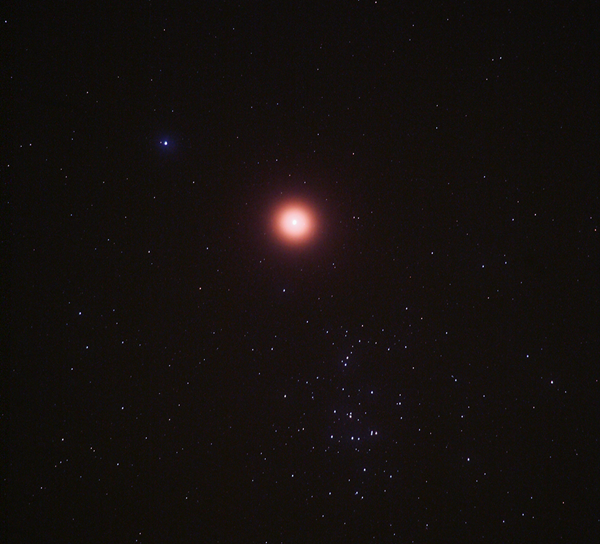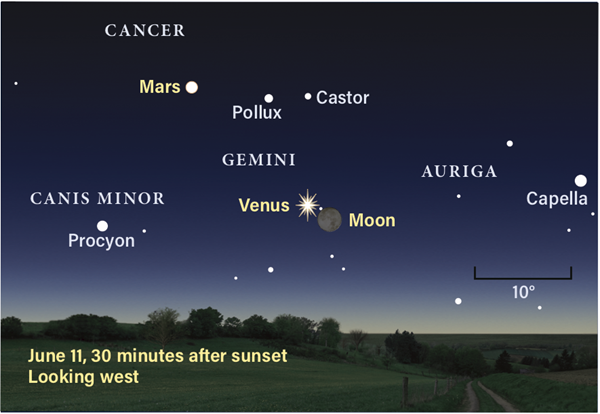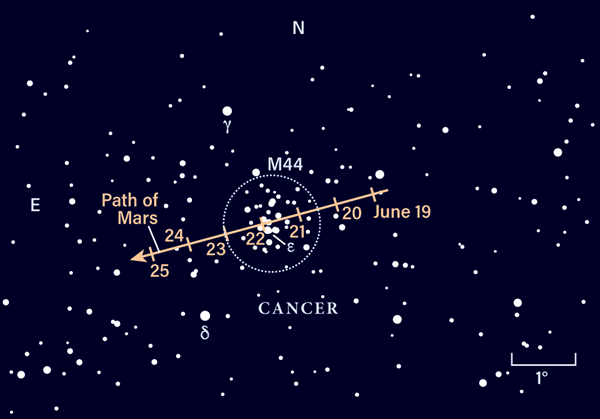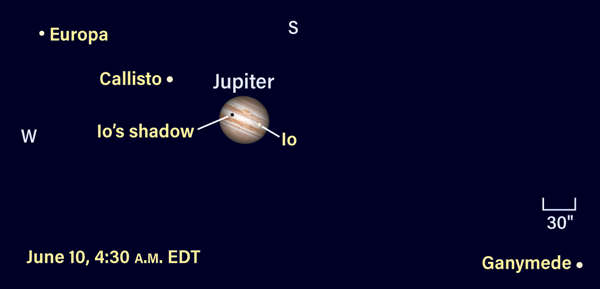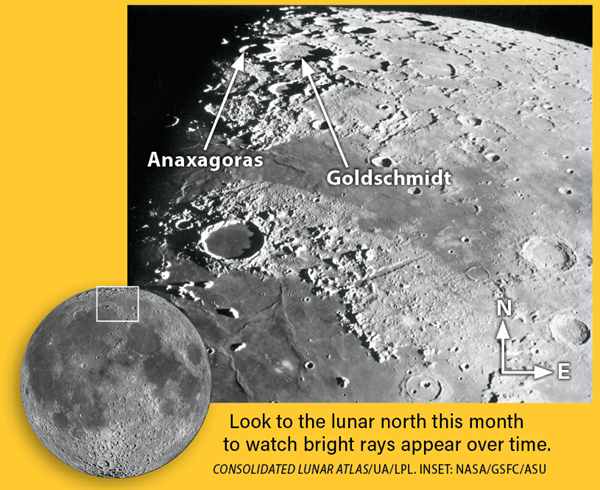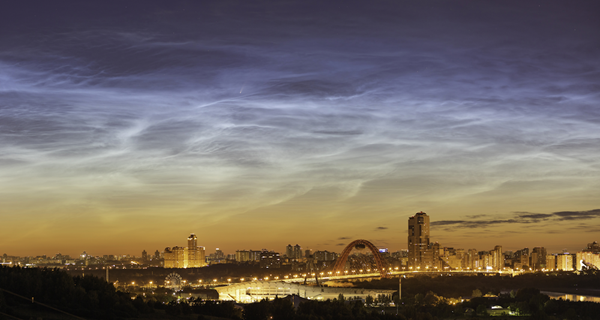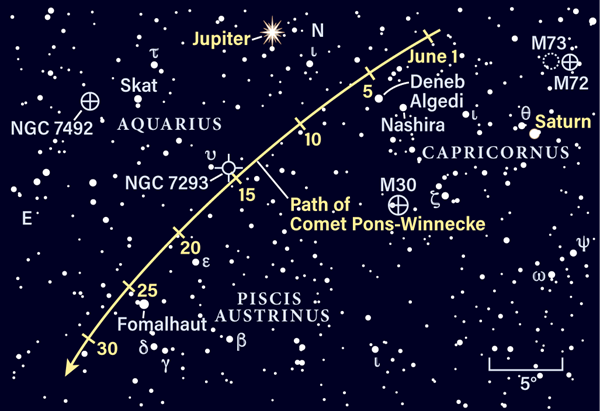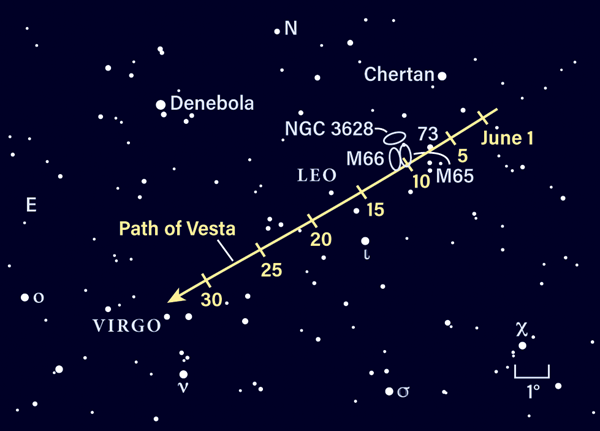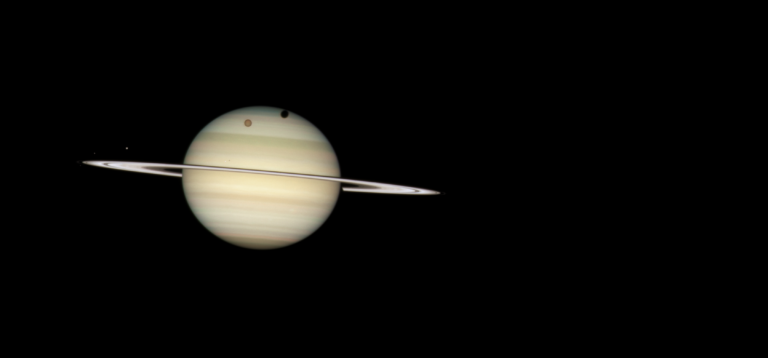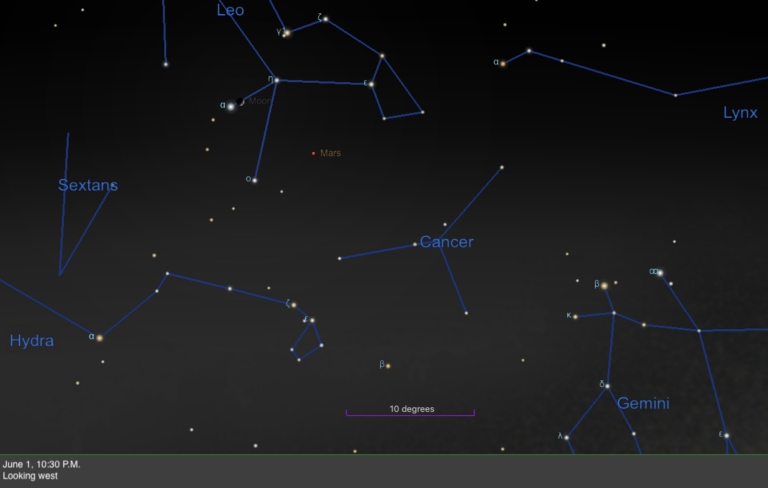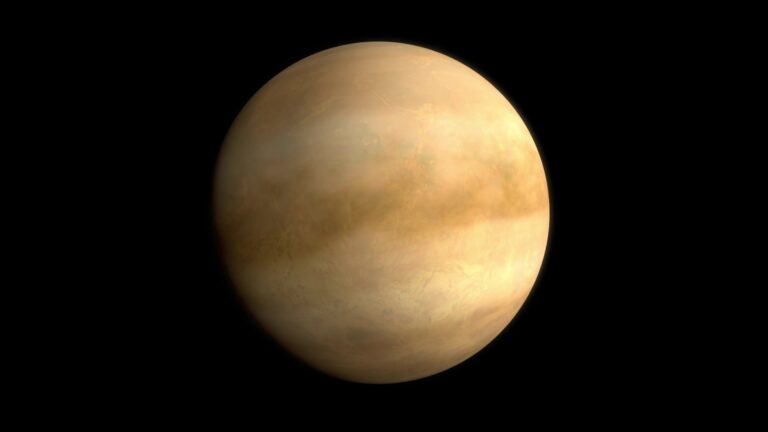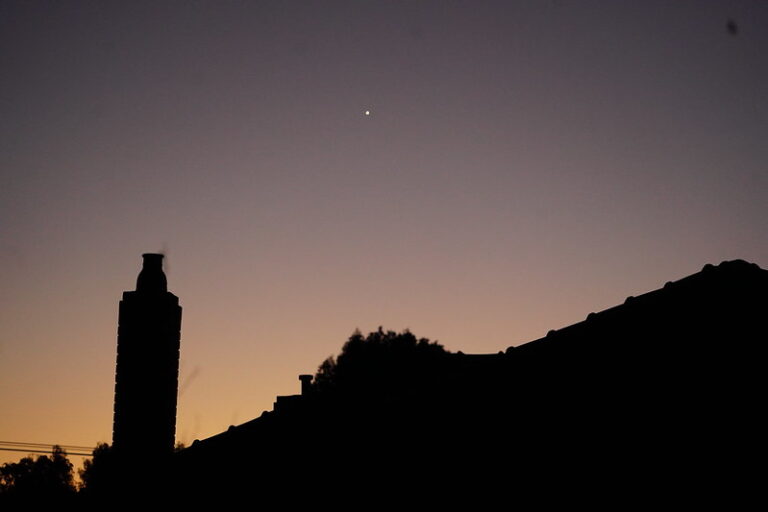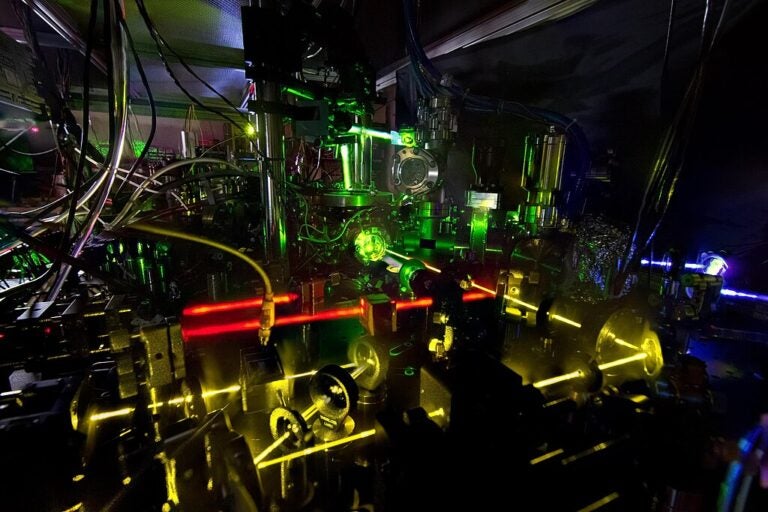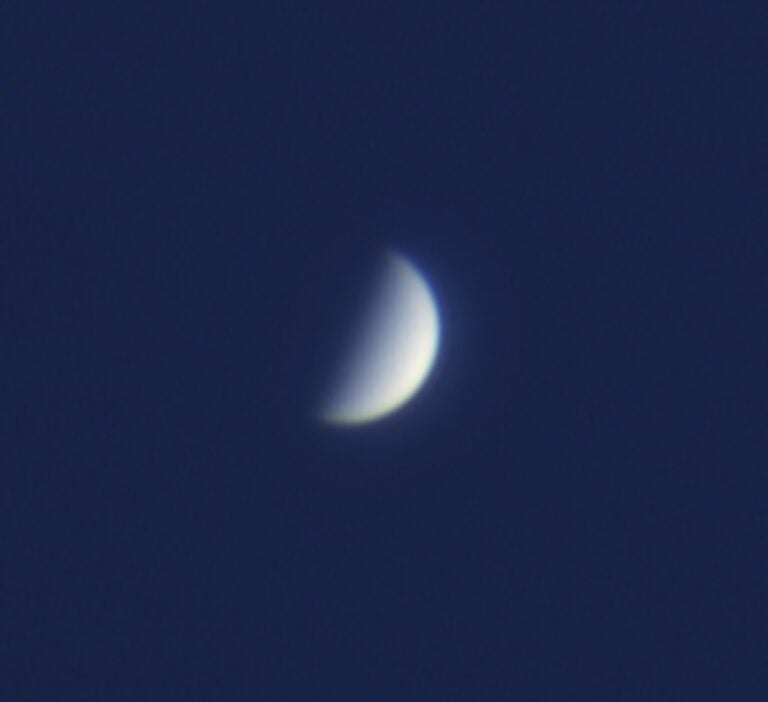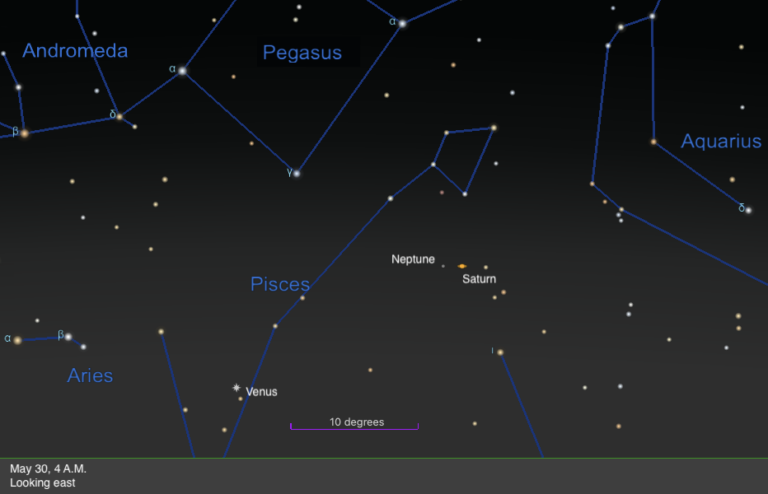An annular solar eclipse crosses parts of northern Ontario this month. Easier targets for observers include the wonderful spectacle of Mars crossing the Beehive star cluster, while Venus dazzles in the early evening sky. The solar system’s two giant planets, Jupiter and Saturn, perform well in the early morning hours. Uranus and Neptune are fine binocular objects, both moving close to similarly bright stars this month. Lastly, Mercury attempts to show itself in the last few days of June, but it’s low and difficult in bright twilight.
Venus is the first planet to appear after sunset. It’s low in the western sky at 6° elevation 45 minutes after sunset on June 1. At magnitude –3.9, it easily punctuates the twilight glow and remains visible until nearly 10 P.M. local time.
Locate Venus June 3 and scan east with binoculars as the sky darkens. Can you spot M35, a well-known 5th-magnitude open cluster in Gemini the Twins, roughly 30′ from the bright planet?
Venus and a slender crescent Moon meet the evening of June 11, less than 3° apart. The planet is at its most northerly declination for the year and also reaches perihelion on the 12th. So, while Venus closely follows the Sun, its visibility stays good throughout June.
Venus continues across Gemini and is in line with Castor and Pollux on June 24, just over 6° south of Pollux. By the end of June, Venus is nearly halfway across Cancer the Crab and ends the month 2.7° shy of the Beehive Cluster (M44). As with M35, see if you can spot the cluster to Venus’ east though binoculars in twilight as the pair descends toward the western horizon.
Telescopically, Venus changes very little this month. It’s on the far side of the Sun, revealing a 95-percent-lit disk June 1 that wanes to 90 percent lit by June 30. Meanwhile, the span of the disk grows from 10″ to 11″ in the same period.
Mars begins the month 5.5° due south of Pollux in Gemini and sets just before midnight in early June. The Red Planet shines at a bright magnitude 1.7, nearly 0.2 magnitude dimmer than nearby Castor. The planet’s orange hue contrasts nicely with the star’s A-type white glow; yellow-orange Pollux, a K-type giant, is a closer match for Mars.
June 13 combines a three-day-old crescent Moon, Mars, and the Beehive Cluster. The cluster stands 4.5° southeast of the Moon, with Mars 3° southwest of our satellite.
Mars crosses the 1.5°-wide Beehive June 22 and 23. Now magnitude 1.8, the ruddy planet provides a stunning contrast to the stars of Praesepe (another name for M44). Catch the view through a low-powered telescope, but do it early — the grouping is low in the west and you’ll need a clear horizon to follow it as the sky darkens. Mars sets just before 11 P.M. local time.
Mars ends June still at magnitude 1.8. On the 30th, it lies 4.5° east of M44 and sets around 10:30 P.M. local time. Venus is catching up with Mars — it is now just over 7° west of the Red Planet. Mars remains in the evening sky for several months more, but its great distance from Earth renders a 4″-wide disk — a challenging object even with a telescope. Despite its lack of detail, the Red Planet remains interesting as it traverses the constellations of the ecliptic.
Saturn appears above the eastern horizon soon after midnight local time on June 1, and about two hours earlier on June 30. The planet starts June at magnitude 0.4 and brightens by 0.1 magnitude during the month. Saturn is located in the mid-northern part of Capricornus the Sea Goat and on June 1 stands 0.7° west of Theta (θ) Capricorni, a 4th-magnitude star better seen once the region is high in the sky in the hour before dawn. Early morning viewers will find the waning gibbous Moon 17° farther east in Aquarius. The Moon returns to Saturn’s vicinity June 27, when the ringed planet stands 5° north of our satellite an hour before sunrise.
Saturn’s disk reaches a span of 18″ by mid-June, while its rings reach 42″ wide by June 30. The planet’s yellowish disk may show subtle features through a telescope and its best viewed in the hour before dawn, around 4 A.M. local time. Look for white spots, which indicate a new storm erupting. Such storms are rare, but large ones can dominate the planet over the course of just a few weeks. The ring tilt drops below 17° this month, allowing a glimpse at the southern polar region.
Saturn’s brightest moon, magnitude 8.6 Titan, is an easy target for small scopes. It lies south of the planet June 8 and 24, and north of Saturn June 16. Fainter Tethys, Dione, and Rhea congregate near Saturn and shine at magnitude 10. Enceladus, near magnitude 12, hugs the outer region of Ring A. Iapetus starts June near 12th magnitude, but progressively brightens to 11th magnitude as it moves toward its June 13 inferior conjunction. By June 30, it’s near 10th magnitude and 8.8′ due west of Saturn.
Jupiter rises an hour after Saturn and is about 30° high in the southeast June 1 at 4:30 A.M. local time, just as the first signs of twilight paint the sky. It shines at magnitude –2.4 among the dimmer stars of Aquarius the Water-bearer. Jupiter’s eastward progression slows until it reaches a stationary point June 21. The planet has brightened to magnitude –2.6 and stands 8.5° northeast of a waning gibbous Moon the morning of June 28.
Viewing improves during the month and by June 30, when it rises shortly before midnight, Jupiter stands nearly 40° high at 4:30 A.M. local time. This is the highest Jupiter has been in Northern Hemisphere skies for four years. The higher elevation improves its brightness and clarity as light from the planet passes through less of Earth’s atmosphere.
Jupiter’s disk spans 41″ as June begins and grows to a fine 45″ wide by month’s end. The gas giant is still two months from opposition but offers an outstanding view through telescopes. The main equatorial belts straddle the middle of the planet, while subtle dusky features transit quickly from east to west as Jupiter’s fast rotation period carries them across the visible disk. That rotation period varies with latitude but ranges from five to 10 minutes less than 10 hours, so the motion of features is visible with just a few minutes of careful observation.
Jupiter’s four Galilean moons, Io, Europa, Ganymede and Callisto, are also visible most nights. Their changing positions are fun to track.
Neptune is located in northeastern Aquarius and reaches a stationary point June 26. It rises just after 2 A.M. local time June 1, and two hours earlier by June 30. On the 1st, Neptune stands 5.6° east of Phi (ϕ) Aquarii and due south of the Circlet in Pisces. The ice giant’s magnitude of 7.8 places it within range of binoculars an hour or two before dawn. Its identity is easy to verify, especially with a good star map. Neptune remains within 7′ of a slightly brighter (magnitude 7.2) field star all month, appearing like a double star. Although the planet moves slowly from night to night, its motion relative to this star is easy to notice.
Uranus emerges in the predawn sky and is best found using binoculars in late June, when the planet stands about 20° high as twilight breaks. It lies in Aries, nearly 12° southeast of Hamal, the Ram’s brightest star. Uranus picks up a double during the last few days of the month as it comes close to Omicron (ο) Arietis, a field star of similar brightness to the magnitude 5.9 planet. On June 30, the bluish planet stands 11′ due north of the star.
Mercury reaches inferior conjunction with the Sun on June 10 and moves west of the Sun in late June. It’s too faint to spot in bright twilight until the last week of the month. On June 30, the planet shines at magnitude 1 and is just over 8° east of Aldebaran in Taurus. Look east at 4:30 A.M. local time to find Aldebaran 5° high; over the next half hour, see if you can spot Mercury as it rises while the sky brightens. Observers in the Southern Hemisphere and the tropics have a better view.
Earth’s summer solstice occurs June 20 at 11:32 P.M. EDT.
An annular solar eclipse takes place June 10. Annular eclipses occur when the Moon is farther than average from Earth during a total solar eclipse, making our satellite too small to cover the entire solar disk. This leaves a ring of solar photosphere visible along the center line of the eclipse. The eclipse track runs across the extreme northern regions of Canada, Greenland, and the Arctic Ocean, as well as far northeastern Russia.
In Canada, the annular eclipse will be visible starting about 100 miles northeast of Thunder Bay, Ontario. A partial eclipse is already underway at sunrise (about 5:50 A.M. local time). The low altitude of the Sun when annularity begins just after sunrise means a very clear sky is required to see it. The path continues across barren land until it reaches the Hudson Bay at Polar Bear Provincial Park. Eclipse chasers from the cities of Toronto, Montreal, Ottawa, and Quebec can take Route 11 through North Bay, Ontario, and cross into the path of the annular eclipse just beyond the small town of Mattice, Ontario.
Rising Moon: Splendid spray
Reminiscent of seasonal changes in Earth’s polar regions, the lunar north transforms every month from creeping, cratered shadows to an expansive reflective domain and back again. On the 24th, the high Sun at Full Moon blankets the zone with gray patches and white rays converging toward the young crater Anaxagoras, named after the Greek philosopher.
The progression begins on the 18th, one evening after First Quarter. Goldschmidt, named for a German amateur observer from the 1800s, is a considerable 75 miles wide and sports a freckled floor and a low rim. The relentless bombardment that wore it down has left rounded shadows that extend across its notably shallow floor. Return the next evening, when sharp-edged Anaxagoras has rotated into the light. Its deep insides remain in shadow for another day. Notice how it is carved onto the edge of the sprawling and shallow Goldschmidt. As we near Full Moon, insert a filter or pump up the power to cut down on the glare. Watch Anaxagoras turn into the brightest splotch of rays in the north.
Goldschmidt is similar in age to Tycho and would be just as famous if its impactor had hit at a more convenient latitude, instead of leaving a mark that is foreshortened in the far lunar north. The rays are beautifully defined and evenly spread and the bright, large apron almost obscures its older neighbor. By comparison, the ray system of the much more famous Copernicus appears disorganized.
Meteor watch: Shine bright at night
There are no major meteor showers this month — a lull before late summer, when the shows pick up again. There are minor showers but they are hard to track, generating only a handful of observable meteors per hour. Regularly recording summer meteors helps researchers track these minor showers, so check with the International Meteor Organization (http://imo.net) to help.
Be on the lookout for noctilucent (night-glowing) cloud activity. These pearly clouds appear 50 miles high — more than 10 times the altitude of cirrus clouds. They are produced when ice crystals form on high-flying dust particles. Noctilucent clouds appear between latitudes of 55° and 70° north, remaining in sunlight for hours after sunset during summer. They are usually seen toward the northern horizon.
Comet search: Almost a ringer
This is the year to add no. 7 to our list of periodic comets, a first for most of us. Discovered over 200 years ago by Jean Louis Pons, Comet 7P/Pons-Winnecke sports a surprisingly short period of 6.4 years. You’d think it would be well known, but Pons-Winnecke is so small that it must be nearby for us to see it well.
The comet’s closest approach to Earth occurs June 12, when it comes within 0.44 astronomical unit (1 astronomical unit, or AU, is the average Earth-Sun distance), and astronomers expect it to glow at magnitude 11.5. Back in 1927, it came within 0.04 AU — just 16 lunar distances — and was visible to the unaided eye at magnitude 3.5. Our next decent shot at Pons-Winnecke comes in 2037 (0.27 AU), but 2045 brings us closer (0.21 AU).
The observing and imaging highlight occurs on the 15th, when Pons-Winnecke sits less than twice the diameter of the Helix Nebula (NGC 7293) to the nebula’s southwest. A dark sky and a 6-inch scope are a must, along with the fortitude to search just before dawn breaks and the planning to ensure your equipment is guarded against a soaking dew.
Locating asteroids: Heyo Leo trio
Continuing to dominate the spring and summer asteroid standings, 4 Vesta slowly slips from Leo into Virgo. Shining at magnitude 7.5, this 300-mile-wide space rock might be getting tough for binoculars from the suburbs, but remains easy to locate with a small scope. Look among the bright stars of the Lion’s hindquarters and the Maiden’s head.
Messier fans are familiar with the bright spiral galaxies M65, M66, and their sidekick NGC 3628, which together form the Leo Triplet. From the 7th to the 13th, Vesta is less than 1° to their south, skimming a mere 7′ from 5th-magnitude 73 Leonis on the 7th.
Located toward the outside of the main belt, Vesta moves slowly, giving fewer chances to see it shift during a single session. By a third consecutive night of observing, its 40′ displacement will be obvious on your sketch of a distinct starfield. If you have three hours on the 17th or 21st, you could notice the sidestep.
Coincidentally, on the 17th, asteroid 3 Juno lies on the northeast outskirts of globular star cluster M10 in Ophiuchus. Look for its magnitude 10 glow as this nearby world threads through a field of red giants lurking some 14,000 light-years in the distance.

